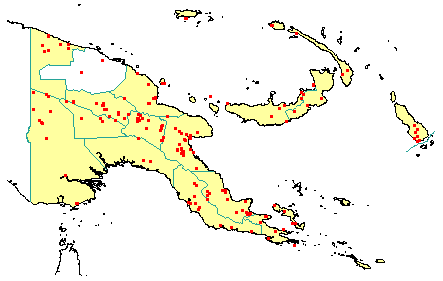
in PNGplants database
PNGTrees – Ficus adenosperma Miq. |
Barry Conn (NSW) & Kipiro Damas (LAE).
Copyright held by the authors, Royal Botanic Gardens and Domain Trust, and Papua New Guinea National Herbarium
Annales Musei Botanici Lugduno-Batavi Vol. 3: 233 (1868)
Other Literature: C.C. Berg and E.J.H. Corner, Flora Malesiana, Series 1 Vol. 17: 352-354 (2005) Fig. 60.
Field Characters: Large trees up to 20 m high or small trees 6-8 m high. Bole cylindrical 11-20 cm diam.; straight bole 2 m long; buttresses absent; spines absent; aerial roots absent; stilt roots absent. Bark white or grey, rough, pustular; lenticels elongated vertically; subrhytidome green; bark thickness <25 mm thick, 3.0 mm thick; blaze consisting of one layer; faintly to non-aromatic; pleasant; outer blaze mixed colours, markings absent, fibrous; inner blaze mixed colours, markings absent, fibrous; exudate present, colourless, spotty, changing colour on exposure to air, to white milky, sticky. Terminal buds enclosed by leaves; complex hairs absent; stinging hairs absent; mature twig without hairs.
Leaves: Spaced along branches <internodes readily visible>. Leaves spiral, simple; petiole present, not winged, attached to base of leaf blade <not peltate>, not swollen; lamina broadest above middle or broadest at or near middle, (4.0-) 8.0-12.0 (-19.0) cm long, (1.0-) 3.0-6.0 (-10.0) cm wide; lamina almost symmetric, margin entire, not dissected or lobed, apex acuminate, venation pinnate <secondary veins arising from the midrib along its length>, secondary veins open <spaced far apart to easily see tertiary veins>, prominent, intramarginal veins absent; lower surface pale green, upper surface green, hairs absent; oil dots absent; domatia absent cystoliths present on both leaf surfaces; stipules present, joined, joined across twigs <growing between opposite leaves and leaving a scar between them when they fall; interpetiolar>, encircling the twig <amplexicaul>, leafy, not fringed, large <easily visible to the eye> 5-25 mm long, not persistent.
Flowers: Inflorescence axillary <from between a leaf and branch> referring to fig or fig arising from just below the leaves, with flowers arranged within a fig or on the trunk or branches <cauliflorous-ramiflorous>. Flowers on an unbranched axis within the fig or flowers arising from a single point figs arranged in pairs; flowers unisexual, with male and female flowers on the same plant <monoecious>, flowers stalked (by misinterpretation) referring to the peduncle of the fig which is about 10 mm long or not stalked, with many planes of symmetry <actinomorphic> male flowers or with one plane of symmetry <zygomorphic> female flowers, 2.5-3.5 mm long, small (< or =10 mm diam.) 1.5-2 mm diam.; perianth present, with all sepals and/or petals (hence tepals) similar, pale white; inner perianth 4-5, free male flowers or some or partly joined female flowers; stamens 3-5, filaments present, free of each other, free of perianth; ovary superior <seated above petals and sepals; hypogenous>, carpels joined (when more than one) <syncarpous>, locules 1; styles solitary <including joined together>, 1 (gynobasic).
Fruits: Fruits arranged on unbranched axis as a stalked fig. Fruit 5-12 mm long, 5.0-18.0 mm diam., fruit green or yellow, not spiny often finely ribbed, fleshy, syconium (fig) <specific example of multiple>, indehiscent, achene individual fruits within fig. Seeds 1, barely visible (to 1 mm long) about 1 mm long, not winged, longer than wide, < 1 mm diam. up to about 0.5 mm diam.
Distribution: Gulf, Western Highlands, West Sepik, Western, Southern Highlands, Papuan Islands, Northern, Milne Bay, New Ireland, New Britain, Madang, Eastern Highlands, Central, Morobe, Bougainville & Manus.
 | Botanical records in PNGplants database |

 .
.